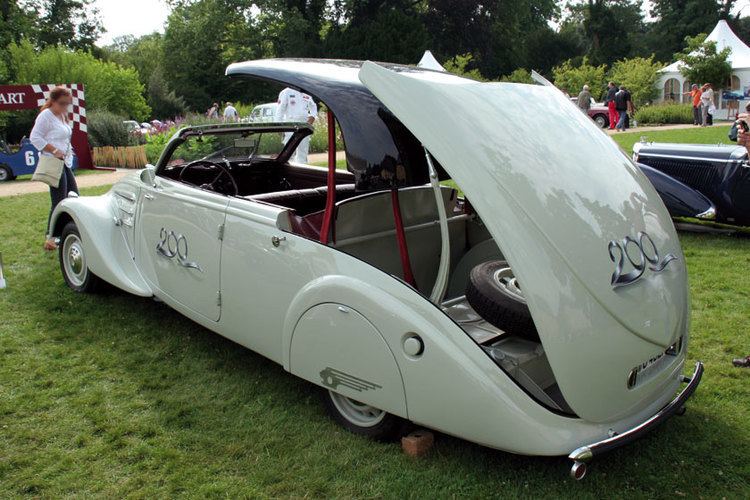 | ||
A retractable hardtop, also known as coupé convertible or coupé cabriolet, employs an automatically operated, multi-part, self-storing hardtop in lieu of a folding textile-based roof.
Contents
Documentation indicates that an American engineer Ben P. Ellerbeck explored the idea of a retractable hardtop as early as 1919 — going so far as to prototype a manually operated system in 1922 that ultimately never reached production. Frenchman Georges Paulin subsequently designed the production 1934 Peugeot 601 Éclipse manually retractable hardtop, followed by the 402 Éclipse Décapotable.
Advances in electronics, hydraulics, and weatherproofing materials have made the modern retractable hardtop increasingly popular. Ease, enclosed car quality climate control with the top up, improved crash resistance, and passenger compartment storage security are traded off against increased mechanical complexity and expense and, more often than not, reduced luggage capacity.
A 2006 New York Times article suggested the retractable hardtop may herald the demise of the textile-roofed convertible, and a 2007 Wall Street Journal article suggested "more and more convertibles are eschewing soft cloth tops in favor of sophisticated folding metal roofs, making them practical in all climates, year-round."
History
1919 Ben P. Ellerbeck conceived a retractable hardtop – a manually operated system on a Hudson coupe that allowed unimpeded use of the rumble seat even with the top down – but never saw production.
1935 Peugeot introduced the first production, power-operated retractable hardtop in 1935, the 402 Éclipse Décapotable, designed and patented by Georges Paulin. The French coachbuilder, Marcel Pourtout, custom-built other examples of Paulin's designs on a larger Peugeot chassis as well. The first Eclipse 402s offered a power-retractable top, but in 1936 was replaced by a manually operated version on a stretched chassis, built in limited numbers until World War II.
1941 Chrysler introduced a retractable hardtop concept car, the Chrysler Thunderbolt.
1953 Ford Motor Company spent an estimated US$2 million (US$17,902,985 in 2017 dollars) to engineer a Continental Mark II with a servo-operated retractable roof. The project was headed by Ben Smith, a 30-year-old draftsman. The concept was rejected for cost and marketing reasons. Engineering work was recycled to the Ford Division which used the retractable mechanism in their 1957-1959 flagship Ford Fairlane 500 Skyliner after an estimated US$18 million (US$153,490,521 in 2017 dollars) more was spent.
1955 Brothers Ed and Jim Gaylord showed their first prototype at the 1955 Paris motor show, but the car failed to reach production.
1957 Ford introduced the Fairlane 500 Skyliner in the United States. A total of 48,394 were built from 1957 to 1959. The retractable top was noted for its complexity and usually decent reliability in the pre-transistor era. Its mechanism contained 10 power relays, 10 limit switches, four lock motors, three drive motors, eight circuit breakers, as well as 610 feet (190 m) of electrical wire, and could raise or lower the top in about 40 seconds. The Skyliner was a halo car with little luggage space (i.e., practicality), and cost twice that of a baseline Ford sedan.
1989 Toyota introduced a modern retractable hardtop, the MZ20 Soarer Aerocabin. The car featured an electric folding hardtop and was marketed as a 2-seater with a cargo area behind the front seats. Production was 500 units.
1995 The Mitsubishi GTO Spyder by ASC was marketed in the U.S. The design was further popularized by such cars as the 1996 Mercedes-Benz SLK. and 2001 Peugeot 206 CC.
2006 Peugeot presented a concept four-door retractable hardtop convertible, the Peugeot 407 Macarena. Produced by French coachbuilding specialist Heuliez, the Macarena's top can be folded in about 30 seconds. It has a reinforcing beam behind the front seats which incorporates LCD screens into the crossmember for the rear passengers.
2006 General Motors introduced a retractable hardtop version of the Pontiac G6 and the Opel Astra. The roof featured a relatively simple two-piece folding design and did not materially reduce rear seat space, although luggage capacity was severely reduced with the roof lowered. Production continued through the 2009 model year.
Construction
Retractable hardtops can vary in material (steel, plastic or aluminum), can vary from two to five in the number of rigid sections and often rely on complex dual-hinged trunk (British: boot) lids that enable the trunk lid to both receive the retracting top from the front and also receive parcels or luggage from the rear – along with complex trunk divider mechanisms to prevent loading of luggage that would conflict with the operation of the hardtop.
Variations
Pros and cons
The retractable hardtop convertible trades higher initial cost, mechanical complexity and, with rare exception, diminished trunk space, for increased acoustic insulation, durability, and break-in protection similar to that of a fixed roof coupe. The tops are also usually heavier than a comparable fixed-roof vehicle or a soft-top convertible, due to the increased strength required for the roof and more complicated roof mechanism, resulting in a potential marginal decrease in performance and fuel economy.
Pros
The retractable hardtop's advantages include:
Cons
In addition to higher initial cost, increased mechanical complexity, and potentially higher repair cost, hardtop cons include:
